How to Become an Influencer (Step-by-Step Guide & Benefits)
Have you always wanted to become famous?
There’s no better time than now! With the rise of social media, everyone can launch an online presence and get thousands of followers.
But where should you start?
We’ve prepared an in-depth guide on how to become an influencer and what you should do to set yourself up for success from the beginning.
Let’s dive in!
Why Should You Become an Influencer?
You are passionate about something, have gained extensive knowledge about it, and now want to share it with the world.
This is an already good enough reason to become an influencer – every industry needs seasoned and proficient experts. However, sharing your insights with the world is only one of many motivations to become an opinion leader in your niche.
Here are three other solid reasons to become an influencer.
Reason #1: Total flexibility in everything
If you follow many influencers on whatever social media platform you prefer and know their stories, you’ve probably noticed that many left their full-time jobs to become independent.
What was the most common reason behind their decision?
Independence.
Most of them tell their audiences that they have made this shift in their lives to start doing what they want to do in the way they prefer. In other words, they prioritized flexibility to achieve creative freedom.
Need an example?
If you’re into YouTube influencers, you might remember the Why I left Buzzfeed trend. Essentially, many creators on the platform who once worked for this company had made the decision to quit because it limited their creative freedom.
One such influencer was Safiya Nygaard, who shared her story on her YouTube channel:
Essentially, the company didn’t let Safiya communicate with people commenting on the videos she produced. Moreover, she couldn’t claim her rights for the project she created, making her contribution practically invisible. So, she quit BuzzFeed to reclaim that creative independence.
If you feel your contribution may be overshadowed or you don’t like limitations being put on your work, taking an influencer’s path could be right for you.
Reason #2: It’s a good side hustle
An Instagram influencer can earn from $180 to $1,800 per post.
Amazing, right?
So, as a creator, you won’t just share your knowledge with your target audience; you can get paid for it. And, depending on the number of social media posts you do per month, this side hustle can bring you more than $20,000. Not too shabby, if you ask us.
By the way, you’d be surprised, but many popular influencers started their social media accounts as gigs outside their main jobs.
Consider Cristine Rotenberg, aka Simply Nailogical, a Canadian YouTuber creating videos about nail art. She started her channel in 2014 while working for the Canadian government (by the way, she’s one of the few influencers who kept their main jobs even after becoming successful).
In 2019, her side hustle grew into a nail polish brand called Holo Taco. And, as of 2022, her company outranked prominent industry players like OPI, Essie, Orly, and Sally Hensen, which Cristine posted about on her Twitter.
So, a gig can safely turn into a full-blown success story. And Cristine’s case is not an exception – Addison Rae opened her beauty brand, Emma Chamberlain’s company sells coffee, Hyram Yarboro launched a skincare line, and Valeria Lipovetsky created a clothing brand.
Reason #3: You get to work with brands you like
When asked what their priorities for 2022 were, 93% of marketers said they wanted to increase their investments in influencer marketing.
Why?
Brands are getting increasingly interested in influencer marketing because of its benefits. The main one is, of course, access to a niche audience via a person who has an impact on them (you can read about other reasons in our guide).
Creators also understand that becoming influencers uncovers a goldmine of opportunities. Mainly, they get to work with their favorite brands and even launch a line of products in partnership with them.
For example, Valeria Lipovetsky, the fashion influencer we mentioned in the previous section, has recently partnered with Lambert, the manufacturer of bags:
She also collaborates with luxury brands like Louis Vuitton and Dior, which she posts about in her Instagram Stories and Reels.
Here, it is important to note that you shouldn’t get into influencer marketing just for the money or brand deals.
Keep in mind that companies want access to your audience, which should possess very specific characteristics:
- Niche-relevant
- Highly engaged
- Specific
These are the reasons why brands choose influencer marketing and social media marketing over traditional marketing – the latter mostly lets you reach a very broad group of people.
And here’s the trick–
It will take a significant amount of time and effort before you can call your audience niche-relevant, highly engaged, and specific.
Many influencers spend years building a community of people who trust them and their recommendations. They do it by sharing their expertise on a subject matter, and it takes a lot of work to prove that your opinion is worthwhile.
Ultimately, the audience you’ll build will showcase your value as an expert in your niche. This audience will also be your trump card when discussing a potential collaboration with a brand.
With the benefits of becoming an influencer clear, let’s move on to the types of creators and their characteristics.
5 Different Types of Influencers
You’d be surprised, but creators also have their career ladder.
As you grow as an influencer, you can jump from one tier to another. Each level comes with new responsibilities and a higher income. So, it is, in fact, like a real job.
Now, let’s explore your options in more detail, so you can better understand what each influencer type entails.
Type#1: Nano-influencer
A nano-influencer is someone with 100 to 10,000 subscribers.
These are often not influencers per se – such creators usually show their life on social media, and people follow them because they find their content interesting.
Interestingly, although nano-influencers don’t regularly promote products and aren’t into the business of working with brands, they have the most engaged audiences. According to Social Shepherd, the engagement rate of their followers is at 5% – higher than with mega-influencers, aka celebrities.
Why is that?
The audience of a nano-influencer typically consists of their family, friends, acquaintances, personal connections, and people generally interested in their life. These people regularly keep in touch with the influencer’s activity.
Secondly, and most importantly, nano influencers usually recommend products they are genuinely passionate about. So, if they promote a product (and it happens rarely), they are very real and authentic about it.
By the way, when brands collaborate with nano-influencers, they usually gift them free products, and it’s up to the creator to promote them.
Example: Cathy Rose
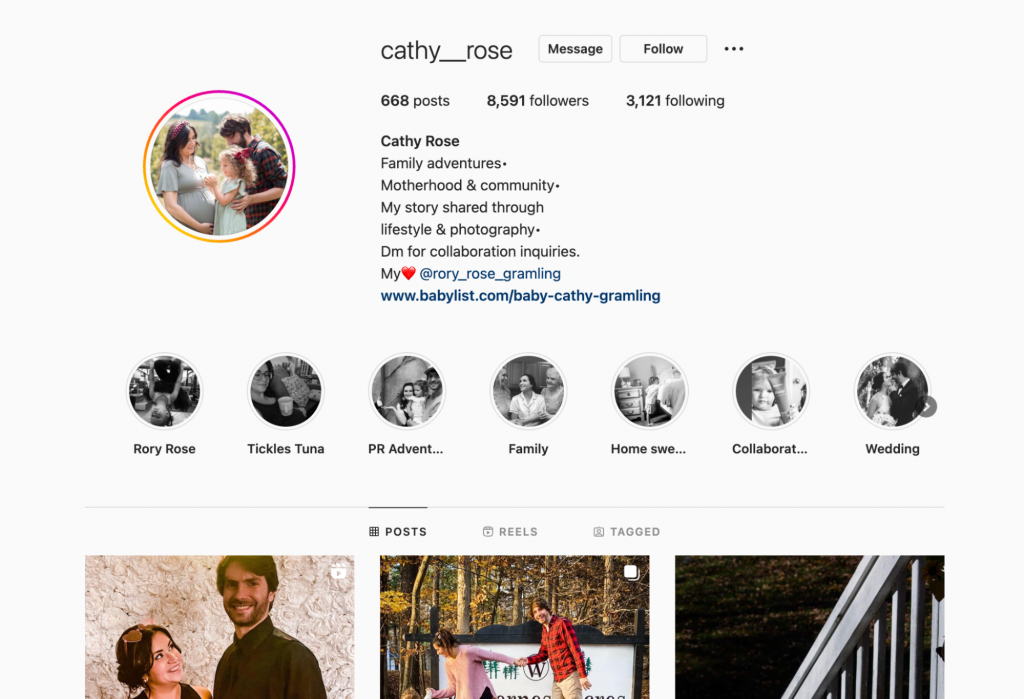
Cathy is a creator sharing her motherhood story. She is a perfect example of a nano-influencer – the content on her Instagram page primarily focuses on her life, with only occasional promotions of products she really believes in.
Type #2: Micro-influencer
Micro-influencers have a social media following with somewhere between 10,000 and 100,000 followers.
A social media profile of a typical micro-influencer focuses on a single niche. Such creators dedicate their social media presence to sharing their expertise, thus, they have a very specific audience.
Need an example?
Think about a food blogger you maybe follow on Instagram or YouTube. Why are you following them? You want to learn some recipes from them, and the content they share really contributes to improving your cooking skill.
Micro-influencers are often very experienced in what they do, so their content is usually pretty insightful and helpful.
Example: exploreaddict
Maxime, aka @exploraddict, is a TikTok influencer who talks about all things traveling on her channel:
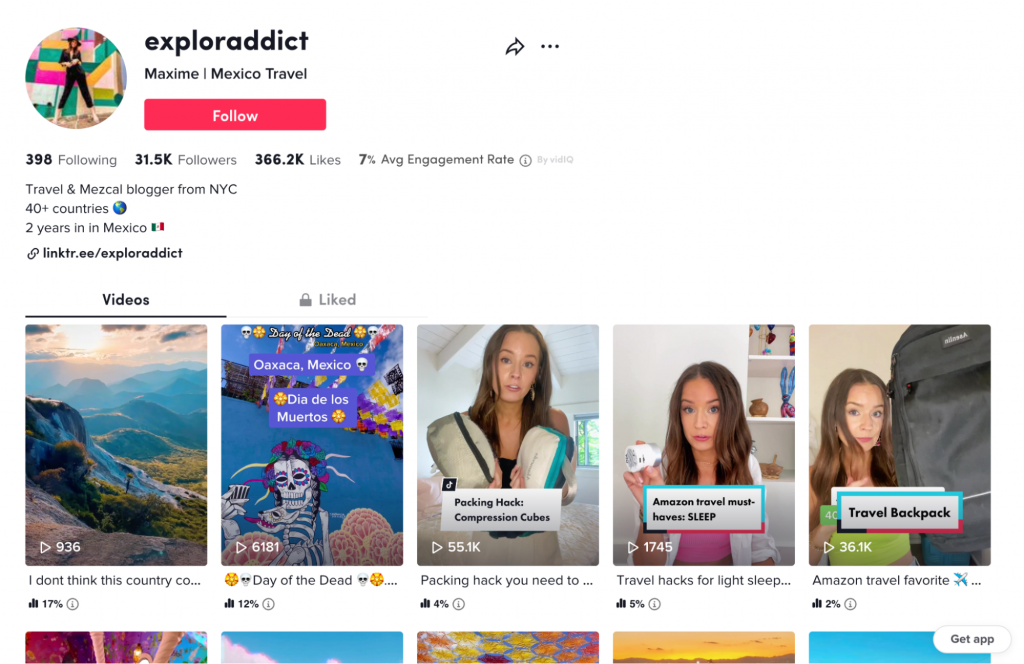
Maxime has traveled to 40+ countries, so she has quite a large knowledge baggage (pun intended) full of exciting tips. For instance, she shares packing tips and tutorials using compression cubes instead of regular ones if you want to fit more stuff into your luggage.
It’s clear with the content micro-influencers produce, but what about paid sponsorships?
So, because micro creators are very niche-specific, they usually collaborate with the brands from their niche. These companies are looking for endorsements from people who have the full trust of their followers, and that’s exactly what micro-influencers guarantee.
Thus, if you have expertise in a specific knowledge field and want to work with brands related to it, consider the level of micro-influencers.
Type #3: Mid-tier influencer
A mid-tier influencer usually has between 100,000 and 250,000 followers.
We can say that a creator of this level occupies a sweet spot, as they have a pretty large audience which still brings decent engagement rates – 1.6% (as a reminder, nano-influencers have 4-5%, and micro creators have 2%) and have turned their online presence into a personal brand.
So, what kind of content do these influencers usually produce?
Mid-tier creators can be experts in their field but can also dedicate their channels to a wider variety of topics, which can be visible from the example below.
Example: Lily Pebbles
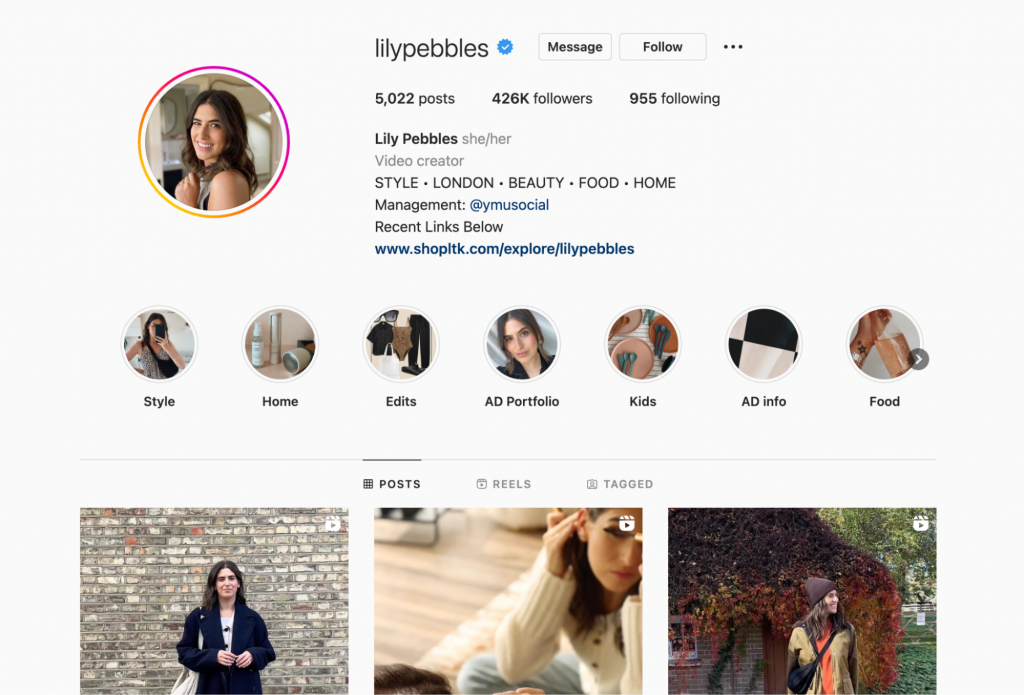
Lily Pebbles is a London-based influencer. She’s also a video creator with a YouTube channel of 474K followers. Her videos and Instagram posts cover the topics of beauty, style, food, and home, and she also films vlogs of her everyday life.
So, as you can see, Lily doesn’t belong to one particular niche, but she still presents a high value to brands because of her large and loyal following base.
Moreover, mid-tier influencers like Lily are very professional since they are creators with a full-time job of collaborating with brands. Such influencers are more likely to land partnerships, become affiliates, brand ambassadors, and get offers from big fish on the market.
Type #4: Macro-influencer
The audience size of a macro-influencer can range from 100K to 1 million.
This influencer status can be compared to a celebrity. The audience of these creators is not homogenous, so brands don’t usually hire a creator of this size to gain credibility in their industry (consider micro-influencers for this purpose).
What macro-creators can help brands do, however, is improve brand visibility.
How?
The secret is in their audience. Macro-influencers have been in their business for quite a while and know their followers and their needs well enough.
That’s why you will never see an irrelevant post on their feed – such influencers know their followers rely on their recommendations. This level of loyalty is exactly what can work in a brand’s favor if it wants more awareness.
By the way, this reason is, among many others, why 72% of marketers prefer working with macro-creators.
Example: Maria Hatzistefanis
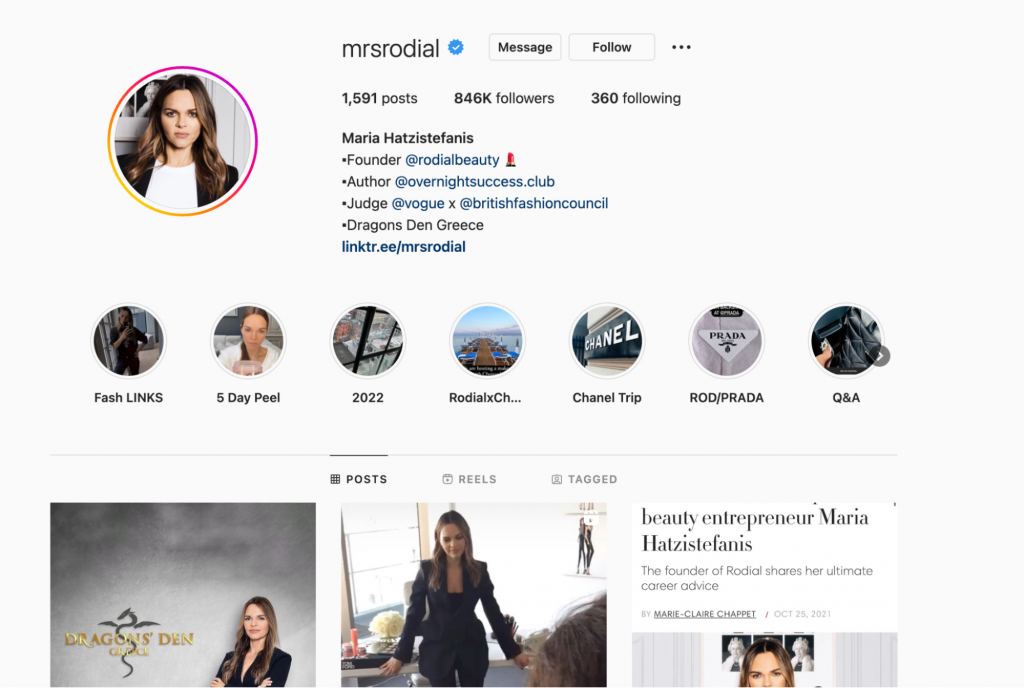
Maria is the founder of Rodial Beauty and a judge at Vogue and British Fashion Council.
Aside from promoting her own brand, she also partners with other influencers to run sweepstakes and shoutouts and works with fashion and beauty companies her audience would find relevant to their needs.
Type #5: Mega-influencer
Mega-influencers are usually celebrities with 1+ million followers.
Naturally, becoming a creator of this size is a dream come true for all beginner influencers. However, it’s a long road ahead.
Unless you become an overnight sensation or happen to star in a reality TV show, it will take you years before you can call yourself a celebrity.
Most creators of this size have been around for a while and started with a small number of followers that grew parallel to the influencer’s online presence. Besides, the majority of celebrity creators have started as nano-influencers with a focus on a specific niche.
What type of content would you post as a mega-influencer?
It can or cannot be niche-specific – your activity will mostly cover your life, current projects, your brand (if you found a company), etc. The engagement of your followers will be low (around 1.6%), but you will get a chance to work with renowned brands and make a living out of it.
Example: Alfie Deyes
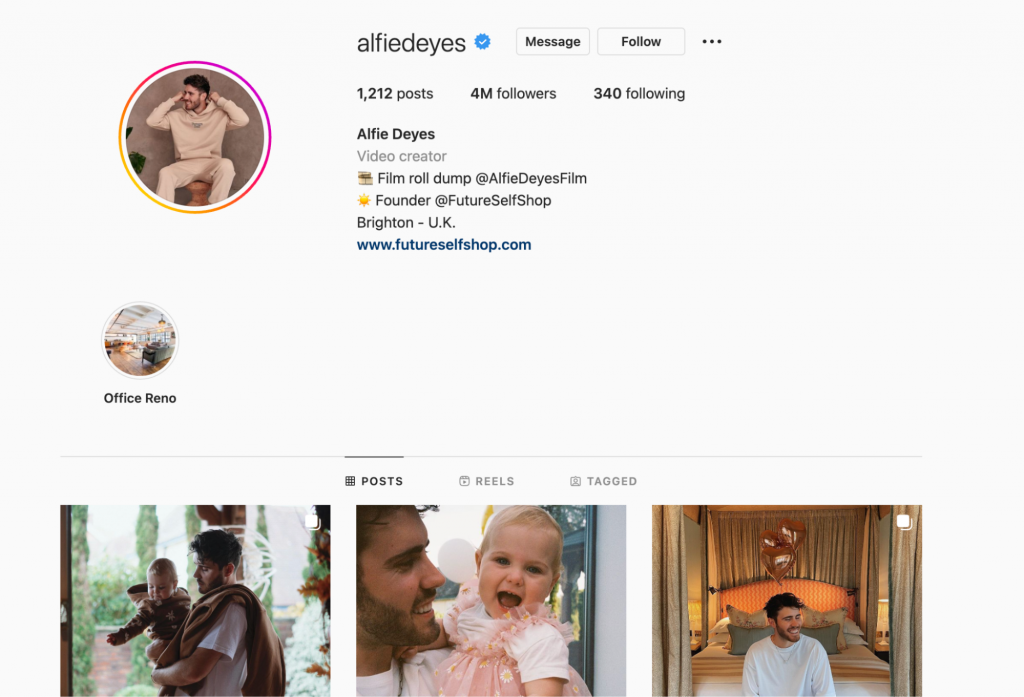
Alfie is a video content creator who started his journey as a nano-influencer talking about his life. He’s also a partner of Zoella, another popular creator and YouTuber. Together, they founded Future Self Shop, an online store that sells clothes.
With 4 million followers, Alfie can afford to partner with massive brands such as Sky Mobile and even Aliexpress. He’s also a Facebook influencer with 1.4 million followers and has a channel on YouTube.
By the way, this is another factor that differentiates a mega-creator from other influencer types – a celebrity has a presence on multiple platforms, and on all of them, they have over 1 million followers.
Alright, it’s now clear that you have quite a few options of what influencer type to become.
But where should you start?
We’ll cover that in detail in the following section.
How to Become an Influencer: Step-by-Step Guide
It may seem that most creators just wake up famous, but it’s far from true.
In reality, they spend a lot of time figuring out the direction for their social media presence. In particular, they have to figure out how to connect their content with the needs of their audience.
If you’re wondering how to get there, we have it all here broken down into seven steps.
Step #1: Identify your niche
Tapping into your interests is the first thing you should do to figure out your influencer niche. Most likely, you’ve already reached a certain level of proficiency in your area of expertise, so why not use it?
Once you have that in place, you should check the demand for your value proposition. Will people want to follow you?
Here, thorough research comes into play.
First, you can search for hashtags containing keywords related to your niche. This marketing strategy will help you see if people, in fact, are interested in what you want your activity to cover.
Tip: try to keep your keywords field-specific. So, instead of searching for #photography in general, look for #portraitphotography if that’s what your online presence will relate to.

The algorithm of some social platforms, like Instagram and Twitter, will also suggest hashtags connected to the main one, making demand analysis of demand a bit easier. These hashtags also reflect influencer trends on a given social network.
Next, you want to run a competitor analysis to better understand what other influencers in your niche put up on their social media channels.
Tip: don’t focus your research on mega- or macro-influencers right away. Instead, to understand what it takes to enter a specific niche as an influencer, you need to study the activity of nano- and micro-creators, whose content has a very narrow focus.
So, if you plan to start an Instagram account on portrait photography, you can check out what Josy Kleine and other influencers of this tier are doing to attract more followers with their content.

Once the niche is crystal clear to you, you can move on to the next step – choosing a channel where you’ll build your presence.
Step #2: Choose the right social media platforms
Most influencers begin their journey on social media. However, social media platforms aren’t born equal.
In fact, there’s a chance you won’t find followers for your niche on the social media website you prefer. For example, if you want to share insights about copywriting, Instagram will hardly be a good place for it, and you might want to consider LinkedIn instead.
So, that could be your first clue. If your area of interest is in the B2C realm, Instagram, Facebook, and TikTok will work. On the other hand, if your field is in B2B, you should steer in the direction of LinkedIn and Twitter. Facebook might also work here.
If you’re in B2C and unsure which of the social channels to choose, you can look up all the networks by popularity and use that as a deciding factor:
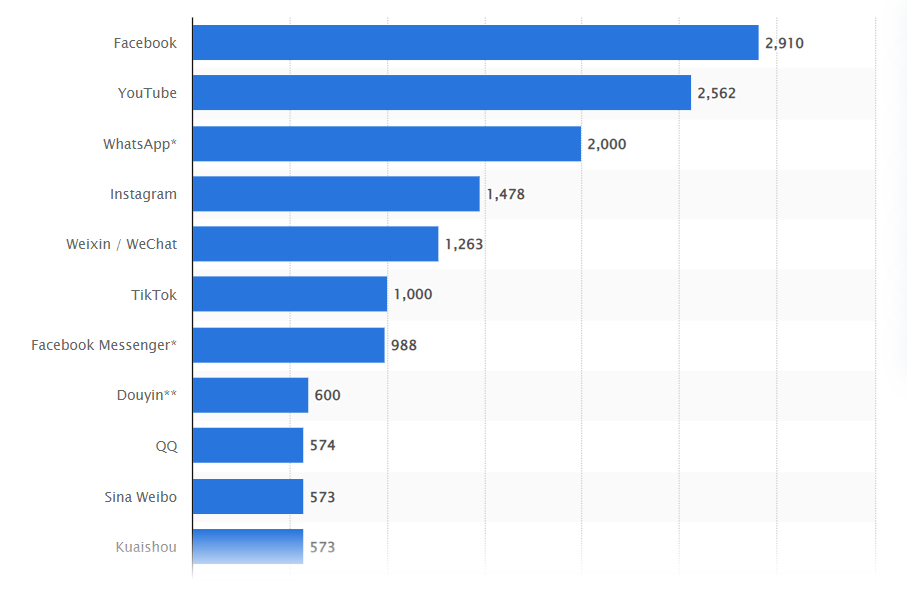
To narrow your research, you can also study the demographics of the typical audience that uses each social network.
Here’s an example of audience distribution by gender:
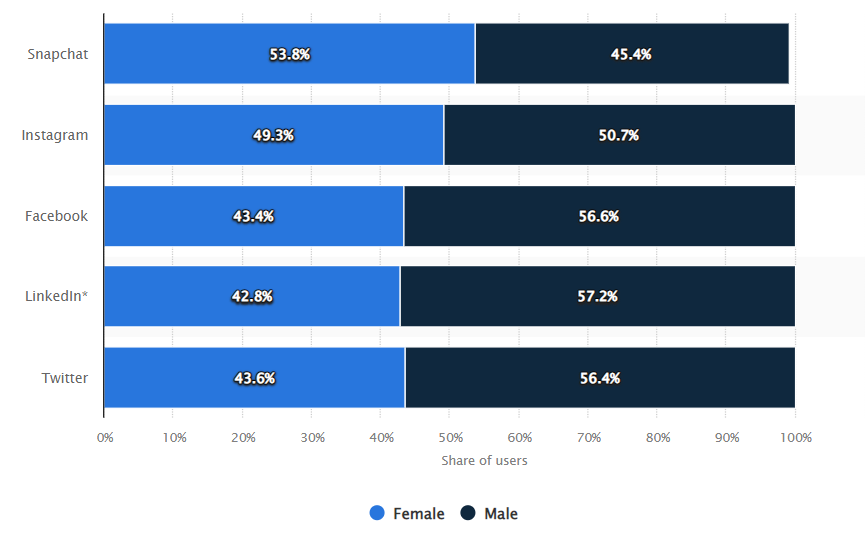
You can also find similar data regarding the distribution by age group.
Step #3: Create quality content
Your content is the currency that will determine your value as an influencer.
So, producing high-quality content from the very beginning of your journey can ultimately set your online presence up for success.
But what characterizes such content?
Overall, social media influencers (and not only) should seek to create content with the following qualities (we touched upon them in our content marketing guide):
- Authentic
- Informative
- Compelling
- Accurate
- Engaging and thought-provoking
- Actionable
In other words, everything you put up online should bring obvious value to your target follower.
Now, many people trying to get into the influencer business focus all their efforts on getting brands to notice them. In other words, they are in for the money, not the value they can offer.
Needless to say, you will not succeed if you follow this pattern.
Instead, all your efforts should go into sharing something insightful. Yes, it won’t pay the bills immediately, but it will lay the foundation for the possibility of monetizing your blog in the future.
Take Cherell Farrugia, a health anxiety coach. She started her Instagram and YouTube channel by sharing her hypochondria story and providing helpful advice for people with a similar disorder:
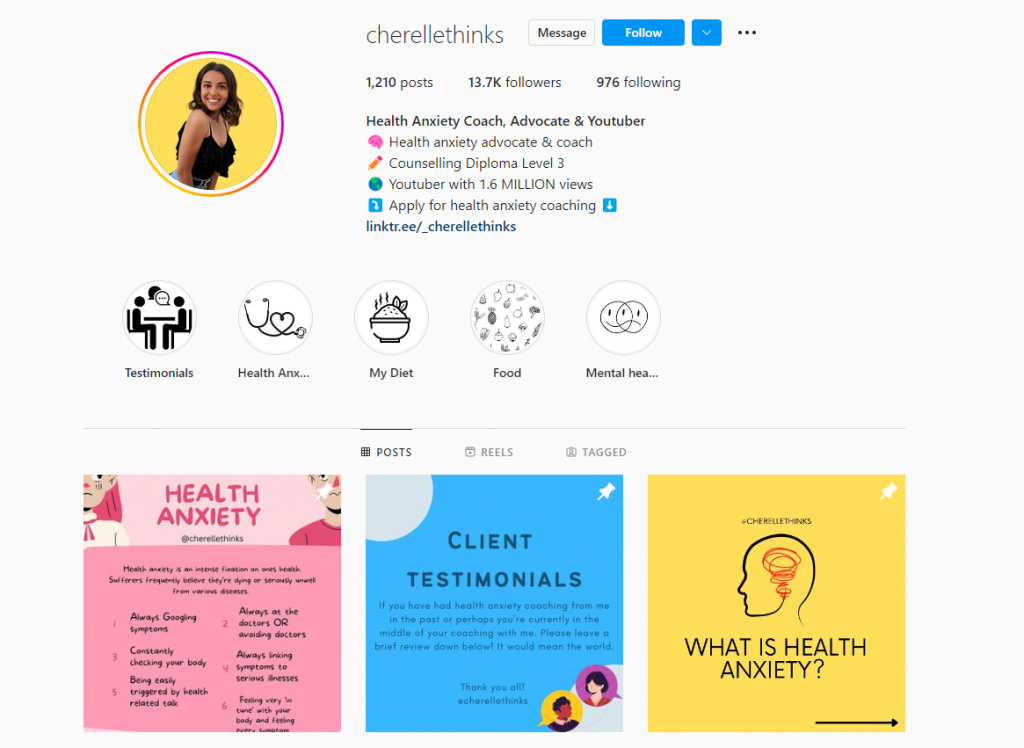
After a while, she managed to open her own health anxiety counseling practice, but it was not the initial focus of her blog.
So, concentrate on creating something truly valuable and meaningful if you want to stand out from the competition.
Step #4: Stay consistent
Once you have your niche and social network figured out, the question arises–
How often should you post content?
The answer will depend on the amount of research that will go into producing a single piece of content. The social media channel you’ve chosen for your activity is another factor.
With Instagram, you want to post fairly often since follower engagement on this platform decreases with low posting frequency. The same goes for TikTok and Twitter.
YouTube is a bit more forgiving in this regard since it takes a creator a while to prepare for, film, and edit a piece of content. As for Linkedin and Facebook, you can post less often there compared to Instagram and TikTok.
However, no matter what channel you choose, consistency is key. Here’s an example explaining why.
One company posted once a week on the same day and time on their blog. In six months, the new visitor traffic to this blog increased by 90%, the number of new followers on Facebook – by 30%, Twitter – by 9%, and LinkedIn – by 8%.
So, even if you don’t post frequently but remain consistent, it will grow your presence over time. However, the quality of your content still comes first, so take care of it before anything else.
Step #5: Interact with your audience
Why do people follow influencers?
According to a study, the main motivations include information seeking and information sharing. So, we can conclude that people don’t just want to consume your content. They also want to share their take with you.
Thus, your task as a creator will also be to communicate with your followers. Doing so regularly also has a few tangible perks for you:
- A better understanding of what your audience wants. As a result, you get a chance to improve your content workflow, get new content ideas, and make your tips and recommendations even more relatable. Maybe they want you to do a podcast as well?
- Improved engagement rates. Social media feedback comes in the form of likes, shares, and comments. So, by chatting with your followers, you increase the amount of feedback, which in turn boosts your audience’s engagement.
- Better deals from brands. Interaction with followers is one of the factors companies take into account when assessing your social media activities.
So, commit to reading and replying to social media comments consistently – it has a real impact on growth.
Step #6: Take advantage of trends
If you look at the majority of influencer marketing campaigns, most of them use social media trends to get public attention.
Let’s look at an example.
Walmart took advantage of top influencers and trending sounds to launch its TikTok campaign #dealdropdance:
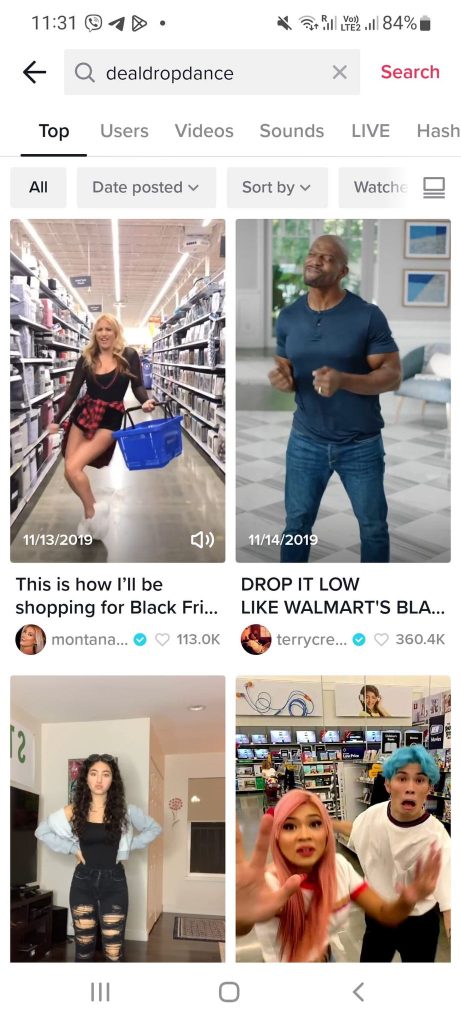
The trend was picked up by smaller creators pretty fast, too, which they used to get their content noticed.
So, if you’re a new creator and struggling to get more people to follow you, using influencer marketing trends on the social media platform where you’re active is a must.
On TikTok, as we’ve mentioned earlier, you can look up the most popular sounds and hashtags. However, you’ll have to do a bit more research for other social networks.
What would this research include?
You can study the hashtags, and some platforms display the trending ones every day (e.g., Twitter). However, the search for trends primarily relies on social listening and keeping an eye on your top competitors with a large follower base – they often determine what’s popular in your niche.
Step #7: Partner with brands
When you have enough followers and a content strategy in place, you can start looking for partnerships.
Yes, that’s right, there’s no reason to sit and wait until someone offers you to do a sponsored post. Instead, you can take this matter into your own hands and start the outreach process.
But first, have a clear understanding of your values.
Influencers often jump into the first collaboration opportunity and create sponsored content without researching a brand. As a result, they get in trouble with their audience because the brand either has a shady history or doesn’t represent what you and your followers stand for.
So, pick your partnerships carefully.
Regarding where to look for brand collaborations, consider adding automation tools, like Upfluence and Grin, in your influencer media kit. They specialize in connecting creators and companies looking to boost their sales or awareness.
Speaking about your media kit – brand partnership platforms are just a fraction of what you’ll be using as an influencer. Anything related to content production (video editing tools, image background remover, copywritng software), analytics solutions, social media content planning, etc., is a must-have for a professional creator.
Over to You
Successful influencer career is hard work, and there is no perfect template to follow.
If you’re committed to starting this journey, research is everything. It will impact all your activities – from finding the niche to developing a content plan and finding appropriate partnerships.
But if you’re truly passionate about becoming a creator, you will actually enjoy this seemingly daunting work. After all, you’ll get to do what you’re truly passionate about, and what’s better than that?
We’ll be posting more influencer marketing guides in the future, so make sure to stay tuned to our blog!

Mariia is a content strategist and editor at Digital Marketer’s World. She is passionate about educating others on all things marketing and believes in the power of the written word.
